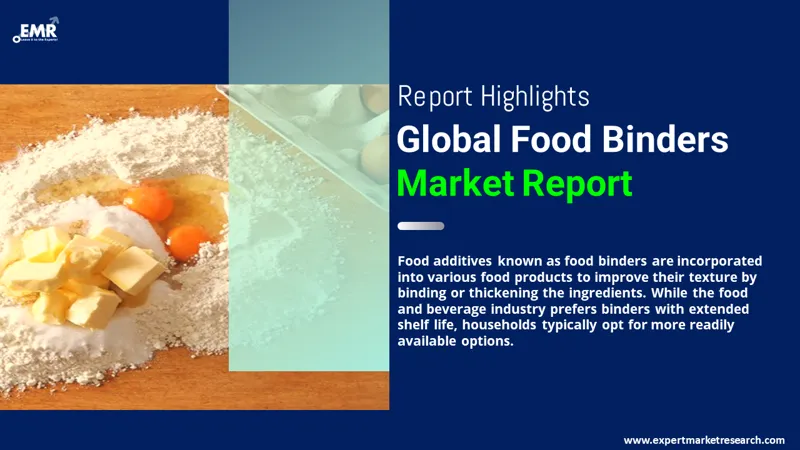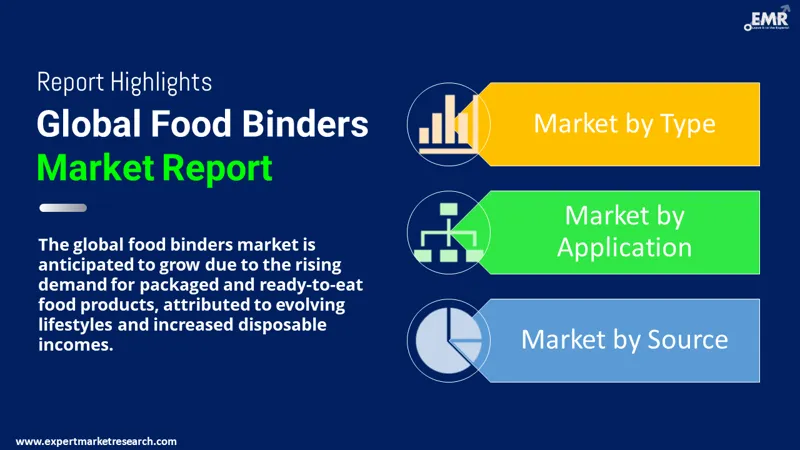
Consumer Insights
Uncover trends and behaviors shaping consumer choices today
Procurement Insights
Optimize your sourcing strategy with key market data
Industry Stats
Stay ahead with the latest trends and market analysis.
The global food binders market is expected to grow at a CAGR of 4.80% between 2026 and 2035 to reach a value of about USD 11.77 Billion by 2035, driven by increasing demands for packaged and ready-to-eat foods.
Base Year
Historical Period
Forecast Period
Compound Annual Growth Rate
4.8%
2026-2035
*this image is indicative*
Food binders are known as food additives that are added to any food product with the intent of enhancing the texture by binding or thickening the ingredients together. The food and beverage industry uses food binders that have an extended shelf-life whereas households prefer binders that are easily accessible. Eggs are considered among the most commonly used food binders in household kitchens.
The increasing demand for ready-to-eat and packaged food products is expected to drive the food binders market across the globe owing to changing lifestyles and increasing disposable incomes. This is further expected to increase the utilisation of binding agents in the food and beverage industry.
With the increasing usage of food binders in liquid formulations and sports supplements due to their cohesive nature, the market growth of food binders is expected to escalate.
An upsurge in the number of fitness centres along with various health clubs is likely to boost the market growth of food binders due to surging health awareness among consumers. This is further expected to positively impact the nutraceutical industry across the globe over the coming years.

Read more about this report - REQUEST FREE SAMPLE COPY IN PDF
The EMR’s report titled “Food Binders Market Report and Forecast 2026-2035” offers a detailed analysis of the market based on the following segments:
Market Breakup by Source
Market Breakup by Type
Market Breakup by Application
Market Breakup by Region

Read more about this report - REQUEST FREE SAMPLE COPY IN PDF
The plant based segment is expected to gain momentum in the food binders market at a global level on account of the growing trend for vegetarian diets and veganism. As more consumers focus on the detailed ingredients used in foods they purchase and consume, there is growing demand for entirely vegetarian or vegan foods, fuelling the plant based segment growth the market of food binders across the globe. The nutritional advantages of plant based food binders are further expected to positively influence consumers and enhance the demand for the plant based segment in the market.
Geographically, the Asia Pacific region is expected to augment the food binders market on account of the rapid urbanisation and surging demand for convenience foods. With globalisation of various food and beverage brands, there is increasing demand in countries such as India and China for items that are popularised on social media in other countries. Food binders help in enhancing the taste of new products for regional markets, as well as extending the shelf life for long distance transportation.
Meanwhile, the North American region is projected to propel over the forecast period on account of the strong foundation of the food and beverage manufacturing industry in the region and large volume of packaged food production.
The comprehensive EMR report provides an in-depth assessment of the market based on the Porter’s five forces model along with giving a SWOT analysis. The report gives a detailed analysis of the following key players in the global food binders market, covering their competitive landscape and latest developments like mergers, acquisitions, investments, and expansion plans.
Tate & Lyle PLC is a global leading company in ingredient solutions for healthier food as well as beverages. The company aims to transform lives with help of food science along with technical capabilities and deep knowledge about the food and beverage industry.
Archer Daniels Midland Company is a leading nutrition company across the globe for both animals and humans. The company unlocks the strength of nature, transforming crops into ingredients and solutions for beverages, foods, and supplements for consumers across the globe. It offers a full variety of services and solutions for aquaculture, pets, and livestock.
Ingredion, Inc. provides solutions required to produce delicious and improved products for food and beverage producers. Its taste, insights, sensory science, and texture experts aid in removing formulation barriers and rapidly meet evolving consumer demands.
*Please note that this is only a partial list; the complete list of key players is available in the full report. Additionally, the list of key players can be customized to better suit your needs.*
Other market players include DuPont de Nemours, Inc., CP Kelco (Huber), Roquette Frères, Gelita AG, and Nexira, among others.




*While we strive to always give you current and accurate information, the numbers depicted on the website are indicative and may differ from the actual numbers in the main report. At Expert Market Research, we aim to bring you the latest insights and trends in the market. Using our analyses and forecasts, stakeholders can understand the market dynamics, navigate challenges, and capitalize on opportunities to make data-driven strategic decisions.*
Get in touch with us for a customized solution tailored to your unique requirements and save upto 35%!
The market is assessed to grow at a CAGR of 4.80% between 2026 and 2035.
The major market drivers are the growing urban population along with the increasing preference for convenience foods.
The key market trends include the increasing disposable income among people and the growing popularity of vegetarian and vegan diets.
The various types in the market for food binders include sugar type, starch type, protein type, and protein type.
The various sources in the market for food binders include animal based, plant based, and hydrocolloids.
The primary applications in the market for food binders include bakery and confectionary, beverages, dairy and frozen desserts, sports nutrition, sauces and dressing, and meat products, among others.
The major players in the food binders market are Tate & Lyle PLC, Archer Daniels Midland Company, Ingredion, Inc., DuPont de Nemours, Inc., CP Kelco (Huber), Roquette Frères, Gelita AG, and Nexira, among others.
Explore our key highlights of the report and gain a concise overview of key findings, trends, and actionable insights that will empower your strategic decisions.
| REPORT FEATURES | DETAILS |
| Base Year | 2025 |
| Historical Period | 2019-2025 |
| Forecast Period | 2026-2035 |
| Scope of the Report |
Historical and Forecast Trends, Industry Drivers and Constraints, Historical and Forecast Market Analysis by Segment:
|
| Breakup by Source |
|
| Breakup by Type |
|
| Breakup by Application |
|
| Breakup by Region |
|
| Market Dynamics |
|
| Competitive Landscape |
|
| Companies Covered |
|
Datasheet
One User
USD 2,499
USD 2,249
tax inclusive*
Single User License
One User
USD 3,999
USD 3,599
tax inclusive*
Five User License
Five User
USD 4,999
USD 4,249
tax inclusive*
Corporate License
Unlimited Users
USD 5,999
USD 5,099
tax inclusive*
*Please note that the prices mentioned below are starting prices for each bundle type. Kindly contact our team for further details.*
Flash Bundle
Small Business Bundle
Growth Bundle
Enterprise Bundle
*Please note that the prices mentioned below are starting prices for each bundle type. Kindly contact our team for further details.*
Flash Bundle
Number of Reports: 3
20%
tax inclusive*
Small Business Bundle
Number of Reports: 5
25%
tax inclusive*
Growth Bundle
Number of Reports: 8
30%
tax inclusive*
Enterprise Bundle
Number of Reports: 10
35%
tax inclusive*
How To Order

Select License Type
Choose the right license for your needs and access rights.

Click on ‘Buy Now’
Add the report to your cart with one click and proceed to register.

Select Mode of Payment
Choose a payment option for a secure checkout. You will be redirected accordingly.
Gain insights to stay ahead and seize opportunities.

Get insights & trends for a competitive edge.

Track prices with detailed trend reports.

Analyse trade data for supply chain insights.

Leverage cost reports for smart savings

Enhance supply chain with partnerships.

Connect For More Information
Our expert team of analysts will offer full support and resolve any queries regarding the report, before and after the purchase.
Our expert team of analysts will offer full support and resolve any queries regarding the report, before and after the purchase.
We employ meticulous research methods, blending advanced analytics and expert insights to deliver accurate, actionable industry intelligence, staying ahead of competitors.
Our skilled analysts offer unparalleled competitive advantage with detailed insights on current and emerging markets, ensuring your strategic edge.
We offer an in-depth yet simplified presentation of industry insights and analysis to meet your specific requirements effectively.
Share